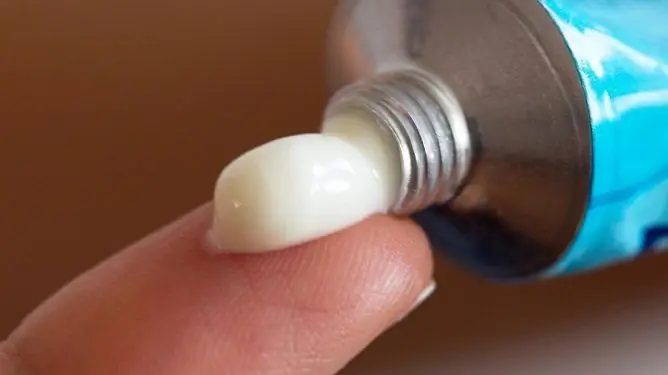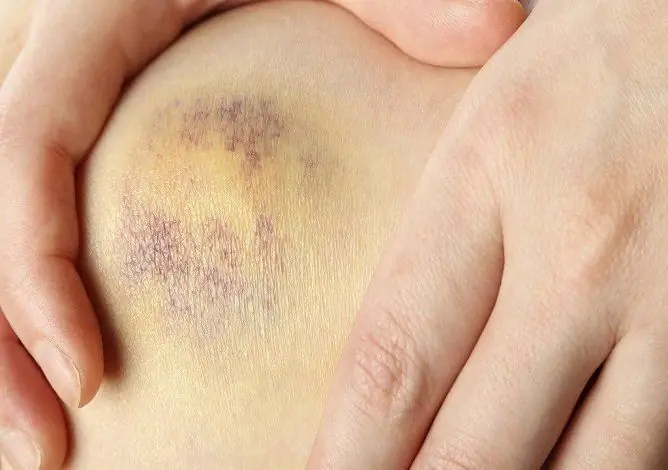- Author Rachel Wainwright [email protected].
- Public 2023-12-15 07:39.
- Last modified 2025-11-02 20:14.
Acute cystitis
The content of the article:
- Causes and risk factors
- Forms of the disease
- Symptoms of acute cystitis
- Diagnostics
- Treatment of acute cystitis
- Potential consequences and complications
- Forecast
- Prevention
Acute cystitis is an inflammatory process mainly of infectious origin, localized in the mucous membrane of the bladder and clinically manifested by frequent and painful urination, low-grade fever, the appearance of blood or pus in the urine.
Acute cystitis is one of the most common urological diseases.

Acute cystitis is inflammation of the lining of the bladder
Causes and risk factors
The infection enters the bladder mainly by the ascending (through the urethra) or descending (from the kidneys) route. Much less often, pathogenic microorganisms enter the bladder by the hematogenous route, that is, they are brought in with the blood flow from the source of the primary infection, or contact through the bladder wall.
Against the background of the inflammatory process, the blood vessels of the bladder wall expand, their permeability increases. The mucous membrane becomes hyperemic and swells. Later, in the focus of inflammation, erythrocyte sweating occurs, which leads to hemorrhagic phenomena. In a severe form of the disease, inflammation can also spread to the deeper layers of the bladder.
Most often, the development of acute cystitis is caused by gram-negative microbial flora (Escherichia coli, Klebsiella, Proteus). Gram-positive microorganisms (staphylococci, proteus), as well as microbial associations, cause inflammation in about 20% of cases.

Mostly gram-negative bacteria lead to inflammation of the mucous membrane of the bladder
Predisposing factors for the development of acute cystitis are parainfluenza, herpetic and adenoviral infections, which cause disturbances in the innervation and blood supply of the bladder wall, which creates favorable conditions for the development of bacterial flora.
Normally, a person's urinary tract is constantly cleansed by a stream of urine. In addition, the cells of the uroepithelium synthesize a special substance of mucopolysaccharide nature, which covers the inner surface of the bladder, thereby protecting it from infection. The production of a protective substance is regulated, among other things, by female sex hormones - progesterone and estrogen. It is in connection with the change in the level of these hormones in women that acute cystitis is more common in the postmenopausal period.
Any damage to the protective mucous layer creates the prerequisites for the development of acute cystitis. Such damage can result from:
- trauma to the inner layer of the bladder (urethroscopy, cystoscopy, bladder catheterization);
- violations of urodynamics, i.e., the correct flow of urine (neurogenic bladder);
- metabolic diseases, accompanied by the development of crystalluria;
- exposure to ionizing radiation, aggressive chemical and toxic substances;
- decrease in general and local immunity, due to frequent viral infections, hypovitaminosis conditions.
In girls and women, acute cystitis most often develops against the background of vaginal dysbiosis (dysbiosis) or as a result of violation of personal hygiene rules. The development of acute cystitis in men and boys is often associated with the presence of anatomical and functional pathology (phimosis, urethral stenosis, neurogenic dysfunction, diverticulum or stenosis of the bladder neck).
An important role in the pathological mechanism of the development of the disease is played by stagnation of blood in the small pelvis.
Forms of the disease
In accordance with the clinical picture, catarrhal and hemorrhagic acute cystitis are distinguished. The hemorrhagic form of the disease is characterized by micro- or macrohematuria (an admixture of blood in the urine).
By the degree of spread of the inflammatory process:
- focal (trigonitis, cervical);
- total (diffuse).
Depending on the type of pathogen:
- specific (tuberculous, gonorrheal, chlamydial, trichomonas);
- non-specific.
The risk of developing specific acute cystitis in men and women increases with active sex life with frequent changes in sexual partners.
Symptoms of acute cystitis
The clinical picture of acute cystitis is very bright, it is characterized by:
- imperative (suddenly arising, strongest, often with inability to contain) urge to urinate;
- excretion of urine (miction) in small portions;
- pain and cramps that occur at the end of the act of urination;
- terminal hematuria (an admixture of blood that appears in the urine towards the end of urination);
- change in the transparency and color of urine (cloudy, sometimes with a reddish tint);
- pain, sometimes very intense, in the bladder, anus, perineum.

Acute cystitis is characterized by intense pain and frequent urge to urinate
In acute cystitis, the urge to urinate occurs even when a small amount of urine (less than 150 ml) has accumulated in the bladder, which is caused by reflex contraction of the detrusor. The frequency of urination is determined by the severity of the inflammatory process and can go up to 3-4 times per hour.
Symptoms of acute cystitis with localization of the pathological process in the bladder neck:
- acute constant pain radiating to the head of the penis, anus;
- acute reflex urinary retention caused by spasm of the pelvic floor muscles and the external sphincter under the influence of intense pain irritation.
Diagnostics
Diagnosis of acute cystitis is based on the characteristic clinical manifestations of the disease. The diagnosis is confirmed by the results of laboratory and instrumental examination, including:
- general urine analysis (bacteriuria, leukocyturia, erythrocyturia, a significant amount of mucus and squamous epithelial cells are characteristic);
- bacteriological examination of urine - allows you to identify the causative agent of the disease, as well as determine its sensitivity to antibacterial drugs;
- a general blood test (with an uncomplicated course of acute cystitis, changes are usually not detected, the analysis is carried out in order to determine the general state of health and detect possible concomitant pathology);
- Ultrasound of the bladder against the background of physiological filling (in the cavity of the bladder, an echo-negative suspension is found, a thickening of the inner walls of the organ);
- urodynamic examination (performed with complicated acute cystitis and is aimed at identifying possible neurogenic dysfunction of the bladder);
- study of the secretion of the prostate gland, bacteriological culture of discharge from the urethra, ultrasound of the prostate gland (with acute cystitis in men).
- gynecological examination, microscopy and bacteriological examination of discharge from the vagina, urethra and cervical canal, PCR studies for sexually transmitted diseases (with acute cystitis in women).
After the acute inflammatory process subsides, cystography and cystoscopy are performed in order to clarify the cause of the disease.

Ultrasound of the bladder is included in the complex diagnosis of acute cystitis
Acute cystitis requires differential diagnosis with urolithiasis and bladder tumors, acute paraproctitis, acute appendicitis, and acute pyelonephritis.
Treatment of acute cystitis
In acute cystitis, the patient is assigned to bed rest, a sparing milk-vegetable diet and plenty of drinking (2.5-3 liters of liquid per day). Sexual life is excluded for the entire period of therapy. For the treatment to be successful, it is important to have a daily bowel movement.
In the treatment of acute cystitis, local thermal procedures (warm sitz baths with decoctions of herbs, dry heat on the bladder area) are widely used, which help to reduce the symptoms of the disease. However, hot baths and flushing of the bladder in the acute phase are strictly contraindicated.
Medical treatment of acute cystitis consists in the use of antibacterial, uroseptic, antihistamines and pain relievers. Antibacterial drugs are prescribed taking into account the type of pathogen and its sensitivity to antibiotics. Until the results of bacteriological research are obtained, broad-spectrum antibiotics are used, which are mainly excreted in the urine, as well as preparations of the nitrofuran series.
For uncomplicated acute cystitis in adults, Monural or fluoroquinolones (Ciprofloxacin, Norfloxacin) are used, and in children, nalidixic acid, cephalosporins (Ceftibuten, Cefaclor, Cefuroxime) or Ampiox. The choice of antibiotic is carried out strictly by the attending physician. Antibiotic therapy lasts 7-10 days.

Dry heat on the bladder area helps with acute cystitis
The treatment regimen for acute cystitis can be supplemented by taking herbal remedies. Pharmacy preparations of medicinal herbs with anti-inflammatory, antiseptic, tanning and diuretic effects are recommended.
After the relief of symptoms of acute cystitis, physiotherapeutic procedures are prescribed (inductothermy, UHF, electrophoresis, magnetic and / or laser therapy).
Potential consequences and complications
The most common complications of acute cystitis are:
- the transition of inflammation to a chronic form, characterized by a persistent course, resistant to therapy, with periods of remission and exacerbations;
- interstitial cystitis - the inflammatory process affects not only the mucous membrane, but also the deeper layers of the bladder wall (submucous, muscular);
- paracystitis - the release of the inflammatory process outside the bladder with damage to the surrounding fiber;
- cystalgia - painful and frequent urination, not accompanied by the development of pyuria (often develops in women);
- acute pyelonephritis - an infection from the bladder through the ureters enters the kidneys, causing inflammation in them;
- gangrenous cystitis is a serious complication that threatens rupture of the bladder and the development of peritonitis.
Forecast
The mucous membrane of the bladder has a high regenerative capacity, therefore, provided that treatment is started on time, in most cases, acute cystitis ends with full recovery within 7-14 days. The prognosis worsens with the development of complications.
Prevention
Prevention of acute cystitis includes the following measures:
- regular emptying of the bladder to prevent urinary stagnation;
- correct water regimen, providing sufficient diuresis (1-1.5 liters per day);
- compliance with the rules of personal hygiene;
- adequate and timely treatment of genital infections and other infectious diseases;
- increasing the general immunity of the body (proper nutrition, rejection of bad habits and promiscuous sex life, sports, adherence to the daily regimen);
- the most gentle and gentle execution of urological operations and manipulations on the bladder.
With a predisposition to acute cystitis, it is recommended to introduce cranberry juice into the daily diet, since cranberries contain benzoic acid, an antiseptic excreted in the urine.
YouTube video related to the article:

Elena Minkina Doctor anesthesiologist-resuscitator About the author
Education: graduated from the Tashkent State Medical Institute, specializing in general medicine in 1991. Repeatedly passed refresher courses.
Work experience: anesthesiologist-resuscitator of the city maternity complex, resuscitator of the hemodialysis department.
The information is generalized and provided for informational purposes only. At the first sign of illness, see your doctor. Self-medication is hazardous to health!






